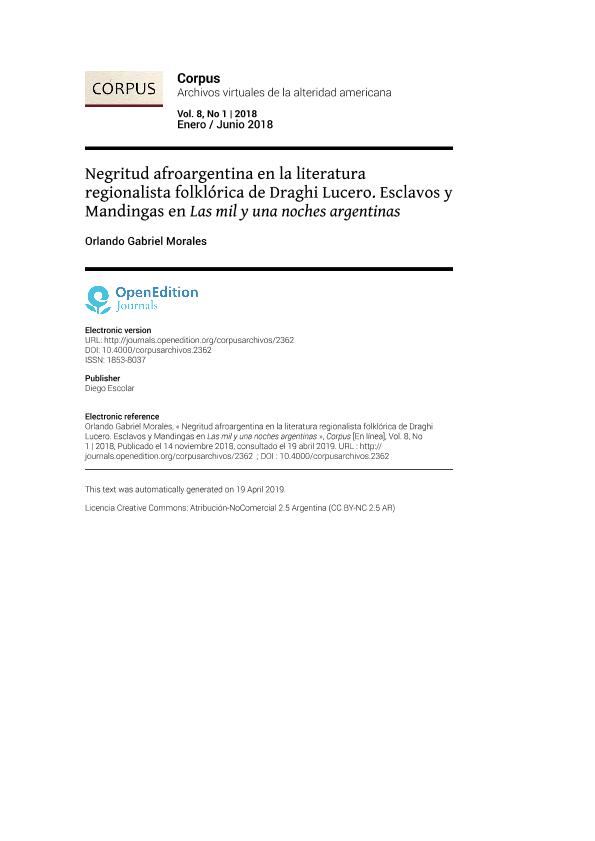Artículo
Este artículo examina las representaciones de la negritud afroargentina en "Las mil y una noches argentinas" (Draghi Lucero, 1940), una obra referente y destacada de la literatura regionalista de inspiración folklórica de Cuyo, del período 1930-1940, que contribuyó a configurar una identidad cuyana. El trabajo contextualiza "Las mil y una noches argentinas" en la trayectoria de Juan Draghi Lucero en las disciplinas del folklore, la historia y la literatura, y pone en diálogo su obra literaria con el criollismo, el nacionalismo y regionalismo cultural de fines del siglo XIX y principios del XX. El análisis expone una narrativa que asume un mesticismo, un folklore y una cultura popular cuyana con énfasis en el aporte precolombino y español, excluyente del elemento africano. También que reproduce ideas comunes de intelectuales argentinos sobre la esclavitud y los africanos esclavizados. Respecto a esto, se identifican dos asociaciones que concatenadas contribuyen a la premisa de la desaparición de los negros argentinos en el siglo XIX: una, entre esclavitud y negros africanos, situados éstos en la sociedad colonial y concebidos como sujetos pasivos beneficiados por relaciones recíprocas de fidelidad/solidaridad con los amos; y otra, menos evidente y más alegórica, entre el fin de la esclavitud o la obtención de la libertad de los esclavos y la desaparición física de los negros. Asimismo, la narrativa apela a estereotipos sociales como la identificación de los negros argentinos con el federalismo y mitos tradicionales de la cultura occidental como la representación del diablo como un hombre negro. This article examines the representations of Afro-Argentinean negritude in Las mil y una noches argentinas (Draghi Lucero, 1940), a reference and outstanding work of Cuyo's folkloric-inspired regionalist literature, from the 1930-1940 period, which contributed to postulate an Cuyana identity cuyana. The work contextualizes Las mil y una noches argentinas in the career of Juan Draghi Lucero in the disciplines of folklore, history and literature, and puts his literary work in dialogue with the criollismo and nationalism and cultural regionalism of the late nineteenth century and early twentieth. The analysis exposes a narrative that assumes a mesticismo, a folklore and a Cuyo popular culture with emphasis on the pre-Columbian and Spanish contribution and excluding the African element. It also reproduces common ideas of Argentine intellectuals about slavery and enslaved Africans. Regarding this, two associations are identified that concatenated contribute to the premise of the disappearance of Argentine blacks in the nineteenth century: one, between slavery and African blacks, located in colonial society and conceived as passive subjects benefited by reciprocal relations of fidelity / solidarity with the masters; and another, less evident and more allegorical, between the end of slavery or the obtaining of the freedom of the slaves and the physical disappearance of the blacks. Likewise, the narrative appeals to social stereotypes such as the identification of Argentine blacks with federalism and traditional myths of Western culture as the representation of the Devil as a dark man.
Negritud afroargentina en la literatura regionalista folklórica de Draghi Lucero. Esclavos y Mandingas en Las mil y una noches argentinas
Fecha de publicación:
06/2018
Editorial:
D. Escolar
Revista:
Corpus
ISSN:
1853-8037
Idioma:
Español
Tipo de recurso:
Artículo publicado
Clasificación temática:
Resumen
Archivos asociados
Licencia
Identificadores
Colecciones
Articulos(INCIHUSA)
Articulos de INST. DE CS. HUMANAS, SOC. Y AMBIENTALES
Articulos de INST. DE CS. HUMANAS, SOC. Y AMBIENTALES
Citación
Morales, Orlando Gabriel; Negritud afroargentina en la literatura regionalista folklórica de Draghi Lucero. Esclavos y Mandingas en Las mil y una noches argentinas; D. Escolar; Corpus; 8; 1; 6-2018; 1-20
Compartir
Altmétricas




